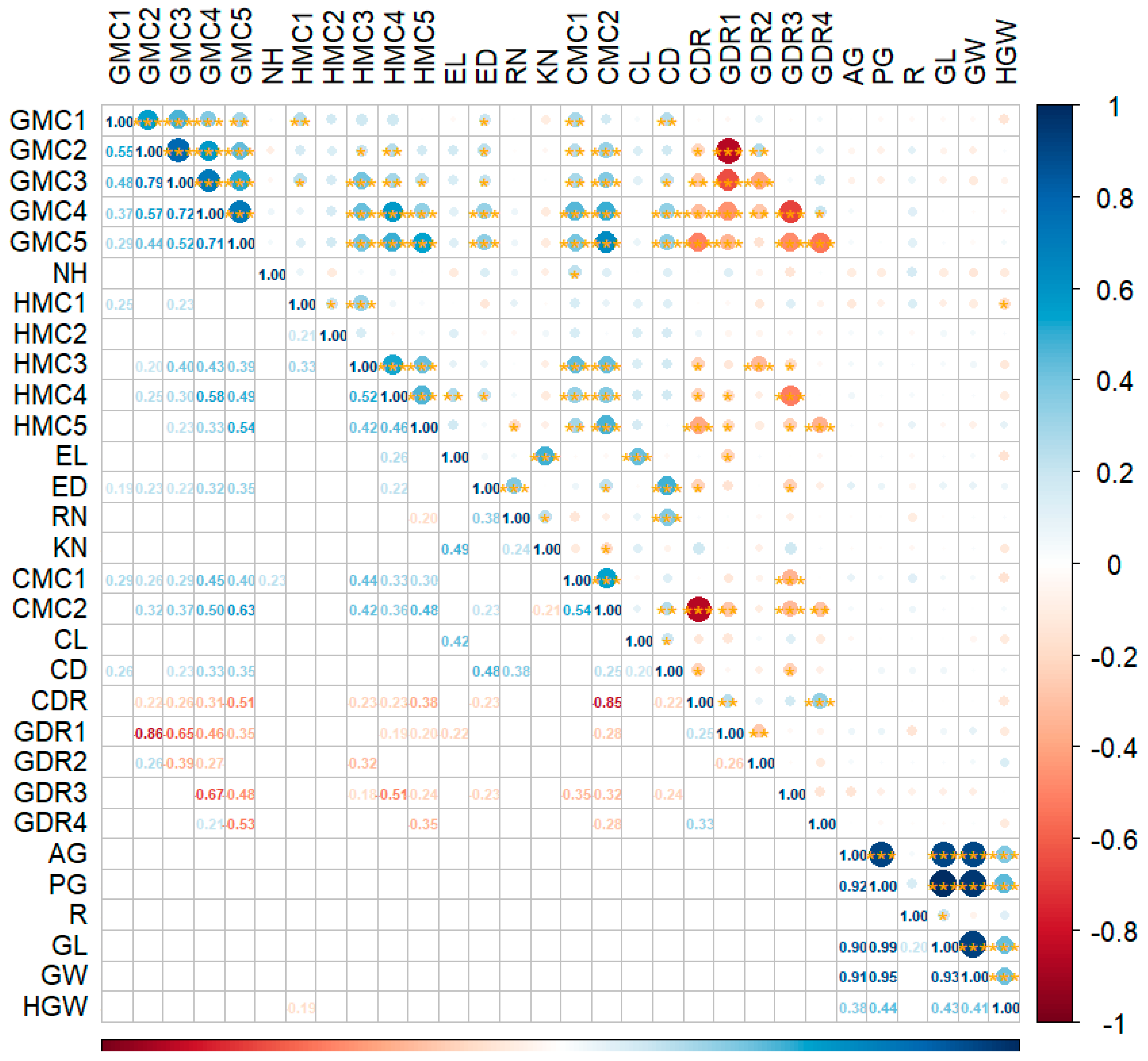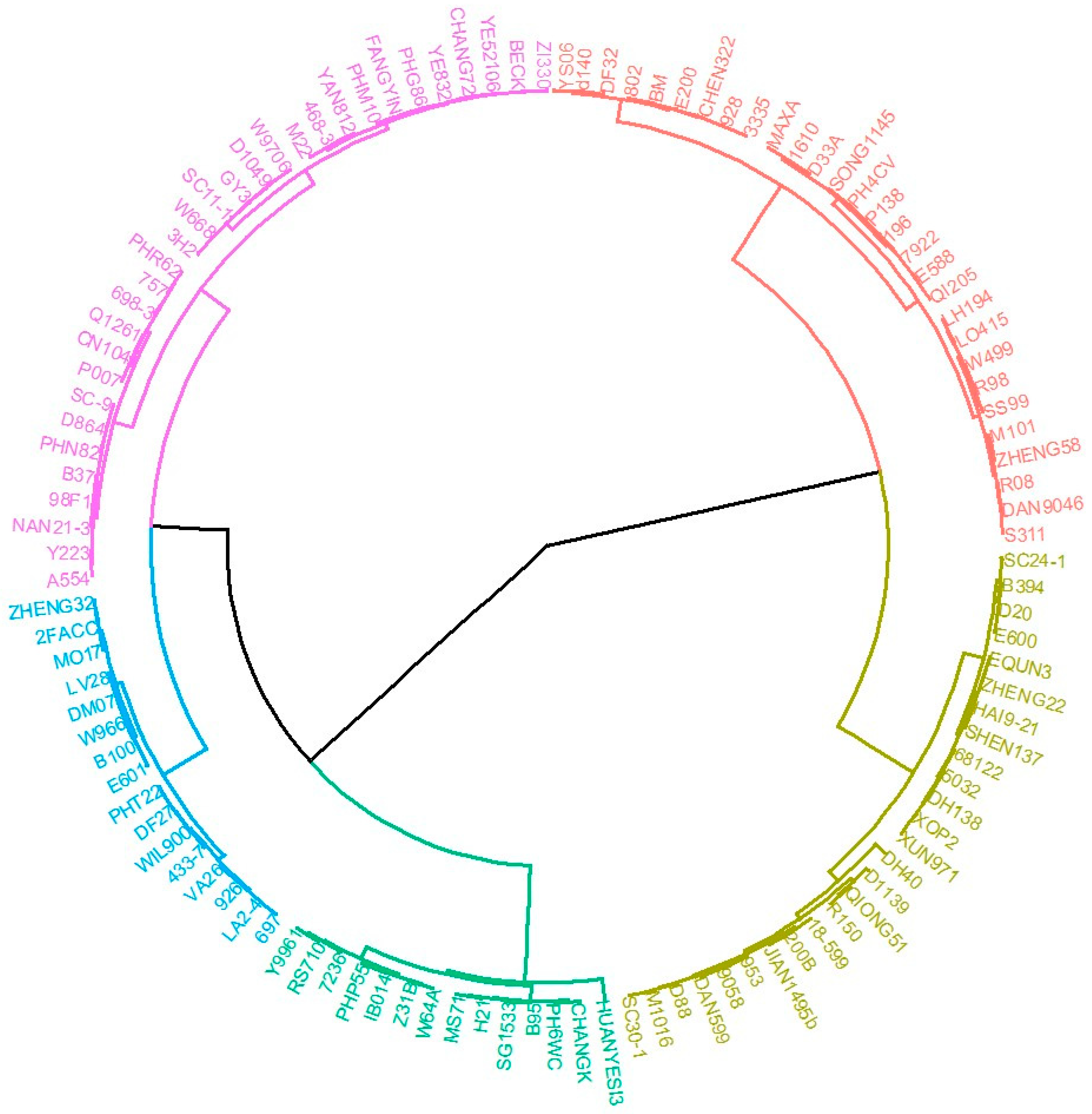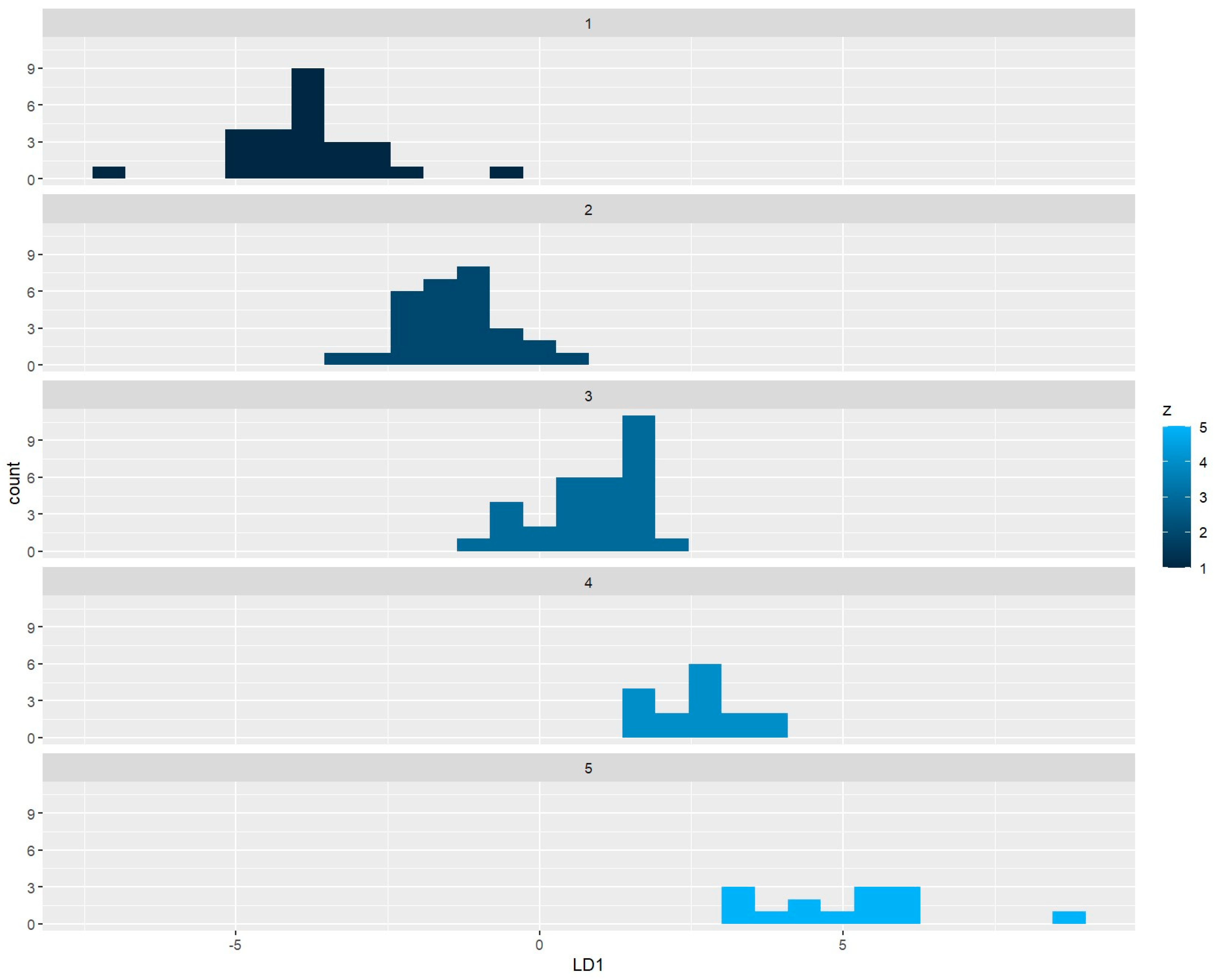Evaluation of Grain Moisture Content at Maturity and Screening for Identification Indexes of Maize Inbred Lines
Abstract
:1. Introduction
2. Materials and Methods
2.1. Plant Materials
2.2. Determination of Water Content in Kernels
2.3. Data Collation and Statistical Analysis
2.3.1. Values of Comprehensive Character Functions of Each Maize Inbred Line
2.3.2. Weight of Each Comprehensive Trait
2.3.3. Comprehensive Evaluation of Grain Moisture Content in Maize Inbred Lines
3. Results
3.1. Variability in Grain Moisture Content Traits
3.2. Analysis of Correlations between the Various Traits
3.3. Principal Component Analysis
3.4. Cluster Analysis
3.5. Discriminant Analysis
3.6. Regression Model Establishment and Verification
3.7. Comparison of Grain Moisture Content Characteristics of Maize Inbred Lines at Maturity
4. Discussion
4.1. Analysis of Maize Grain Moisture-Content-Related Traits and Evaluation Indexes
4.2. Evaluation of Water Holding Capacity and Genetic Improvement of Maize Grains
5. Conclusions
Supplementary Materials
Author Contributions
Funding
Data Availability Statement
Acknowledgments
Conflicts of Interest
References
- Dong, Y.; Feng, Z.Q.; Ye, F.; Li, T.; Li, G.L.; Li, Z.S.; Hao, Y.C.; Zhang, X.H.; Liu, W.X.; Xue, J.Q.; et al. Genome-wide association analysis for grain moisture content and dehydration rate on maize hybrids. Mol. Breed. 2023, 43, 5. [Google Scholar] [CrossRef]
- Li, W.; Yu, Y.; Wang, L.; Luo, Y.; Peng, Y.; Xu, Y.; Liu, X.; Wu, S.; Jian, L.; Xu, J.; et al. The genetic architecture of the dynamic changes in grain moisture in maize. Plant Biotechnol. J. 2021, 19, 1195–1205. [Google Scholar] [CrossRef]
- Brooking, I.R. Maize ear moisture during grain-filling, and its relation to physiological maturity and grain-drying. Field Crops Res. 1990, 23, 55–68. [Google Scholar] [CrossRef]
- Liu, J.; Yu, H.; Liu, Y.; Deng, S.; Liu, Q.; Liu, B.; Xu, M. Genetic dissection of grain water content and dehydration rate related to mechanical harvest in maize. BMC Plant Biol. 2020, 20, 118. [Google Scholar] [CrossRef]
- Li, Y.L.; Dong, Y.B.; Yang, M.L.; Wang, Q.L.; Shi, Q.L.; Zhou, Q.; Deng, F.; Ma, Z.Y.; Qiao, D.H.; Xu, H. QTL detection for grain water relations and genetic correlations with grain matter accumulation at four stages after pollination in maize. Plant Biochem. Physiol. 2014, 2, 1000121–1000129. [Google Scholar]
- Wang, W.; Ren, Z.; Li, L.; Du, Y.; Zhou, Y.; Zhang, M.; Li, Z.; Yi, F.; Duan, L. Meta-QTL analysis explores the key genes, especially hormone related genes, involved in the regulation of grain water content and grain dehydration rate in maize. BMC Plant Biol. 2022, 22, 346. [Google Scholar] [CrossRef]
- Kang, M.S.; Zuber, M.S.; Colbert, T.R. Effects of certain agronomic traits on and relationship between rates of grain-moisture reduction and grain fill during the filling period in maize. Field Crops Res. 1986, 14, 339–347. [Google Scholar] [CrossRef]
- Waelti, H.; Buchele, W.F. Factors affecting corn kernel damage combine cylinders. Trans. ASAE 1969, 12, 55–59. [Google Scholar]
- Plett, S. Corn kernel breakage as a function of grain moisture at harvest in a prairie environment. Can. J. Plant Sci. 1994, 74, 543–544. [Google Scholar] [CrossRef]
- Capelle, V.; Remoué, C.; Moreau, L.; Reyss, A.; Mahé, A.; Massonneau, A.; Falque, M.; Charcosset, A.; Thévenot, C.; Rogowsky, P.; et al. QTLs and candidate genes for desiccation and abscisic acid content in maize kernels. BMC Plant Biol. 2010, 10, 2. [Google Scholar]
- Baute, T.; Hayes, A.; McDonald, I.; Reid, K. Agronomy guide for field crops. Ont. Minist. Agric. Food Rural. Aff. 2002, 811, 31–34. [Google Scholar]
- Kebebe, A.Z.; Reid, L.M.; Zhu, X.; Wu, J.; Woldemariam, T.; Voloaca, C.; Xiang, K. Relationship between kernel dry down rate and resistance to Gibber Ella ear rot in maize. Euphytica 2015, 201, 79–88. [Google Scholar] [CrossRef]
- Xiang, K.; Reid, L.M.; Zhang, Z.M.; Zhu, X.Y.; Pan, G.T. Characterization of correlation between grain moisture and ear rot resistance in maize by QTL meta-analysis. Euphytica 2012, 183, 185–195. [Google Scholar] [CrossRef]
- Purdy, J.L.; Crane, P.L. Inheritance of drying rate in “mature” corn (Zea mays L.). Crop Sci. 1967, 7, 294–297. [Google Scholar] [CrossRef]
- Kang, M.S.; Zuber, M.S.; Horrocks, R.D. An electronic probe for estimating ear moisture content of maize. Crop Sci. 1978, 18, 1083–1084. [Google Scholar] [CrossRef]
- Zhang, D.L.; Sun, Y.J.; Zhao, H.G. Design and experiment of the self-propelled combine harvester for corn and stalk. Trans. Chin. Soc. Agric. Eng. 2005, 21, 79–82. (In Chinese) [Google Scholar]
- Tong, P.Y. Corn grain mechanized harvesting. Agric. Technol. Equip. 2015, 4, 4–6. (In Chinese) [Google Scholar]
- Zheng, Y.; Yuan, F.; Huang, Y.; Zhao, Y.; Jia, X.; Zhu, L.; Guo, J. Genome-wide association studies of grain quality traits in maize. Sci. Rep. 2021, 11, 9797. [Google Scholar]
- Zheng, Y.; Hou, P.; Zhu, L.; Song, W.; Liu, H.; Huang, Y.; Wang, H.; Guo, J. Genome-Wide Association Study of Vascular Bundle-Related Traits in Maize Stalk. Front. Plant Sci. 2021, 12, 699486. [Google Scholar] [CrossRef]
- Zheng, Y.; Gao, X.; Yuan, F.; Liu, Q.; Huang, Y.; Zhao, Y.; Jia, X.; Zhu, L.; Chen, J.; Guo, J. Genome-wide association studies of grain quality traits in maize. Seed 2021, 40, 29–34. (In Chinese) [Google Scholar] [CrossRef]
- Xue, Y.; Warburton, M.L.; Sawkins, M.; Zhang, X.; Setter, T.; Xu, Y.; Grudloyma, P.; Gethi, J.; Ribaut, J.M.; Li, W.; et al. Genome-wide association analysis for nine agronomic traits in maize under well-watered and water-stressed conditions. Theor. Appl. Genet. 2013, 126, 2587–2596. [Google Scholar] [CrossRef]
- Dai, H.F.; Wu, H.; Maimaitiali, A.; Wang, L.H.; Apizi, M.; Zhang, J.S. Analysis of salt-tolerance and determination of salt tolerant evolution indicators in cotton seedlings of different genotypes. Sci. Agric. Sin. 2014, 47, 1290–1300. [Google Scholar]
- Danojevi, D.; Živko, U.I.; Nagl, N.; Taški-Ajdukovi, K.; Anski, J.B. Evaluation of sugar beet genotypes for root traits by principal component analysis and cluster analysis. Genetika 2016, 48, 339–348. [Google Scholar] [CrossRef]
- R Core Team. R: A Language and Environment for Statistical Computing; R Foundation for Statistical Computing: Vienna, Austria, 2015; Volume 14, pp. 12–21. [Google Scholar]
- Patto, M.C.V.; Alves, M.L.; Almeida, N.F.; Santos, C.; Moreira, P.M.; Satovic, Z.; Brites, C. Is the bread making technological ability of Portuguese traditional maize landraces associated with their genetic diversity? Maydica 2009, 54, 297–311. [Google Scholar]
- Kiani, S.; Jafari, A. Crop detection and positioning in the field using discriminant analysis and neural networks based on shape features. J. Agric. Sci. Technol. 2012, 14, 755–765. [Google Scholar]
- Reid, L.M.; Zhu, X.; Morrison, M.J.; Woldemariam, T.; Voloaca, C.; Wu, J.H.; Xiang, K. A non-destructive method for measuring maize kernel moisture in a breeding program. Maydica 2012, 55, 163–171. [Google Scholar]
- Qian, Y.L.; Zhang, X.Q.; Wang, L.F.; Chen, J.; Chen, B.R.; Lv, G.H.; Wu, Z.C.; Guo, J.; Wang, J.; Qi, Y.C. Detection of QTLs controlling fast kernel dehydration in maize (Zea mays L.). Genet. Mol. Res. 2016, 15, 3. [Google Scholar] [CrossRef]
- Yang, J.; Carena, M.J.; Uphaus, J. Area under the dry down curve (AUDDC): A method to evaluate rate of dry down in maize. Crop Sci. 2010, 50, 2347–2354. [Google Scholar] [CrossRef]
- Filipenco, A.; Mandache, V.; Valsan, G.; Ivan, F.; Ciocazanu, I. Inheritance of grain dry-down in corn (Zea mays L.). Agriculture 2013, 70, 223–226. [Google Scholar] [CrossRef]
- Kim, K.B.; Noh, S.H.; Kim, J.H. Development of grain moisture meter using microwave attenuation at 10.5 GHz and moisture density. IEEE Trans. Instrum. Meas. 2000, 51, 72–77. [Google Scholar]
- Freppon, J.T.; Martin, S.K.S.; Pratt, R.C.; Henderlong, P.R. Section for low ear moisture in corn, using a hand-held meter. Crop Sci. 1992, 32, 1062–1064. [Google Scholar] [CrossRef]
- Prado, S.A.; López, C.G.; Gambín, B.L.; Abertondo, V.J.; Borrás, L. Dissecting the genetic basis of physiological processes determining maize kernel weight using the IBM (B73×Mo17) Syn4 population. Field Crops Res. 2013, 145, 33–43. [Google Scholar] [CrossRef]
- Sala, R.G.; Andrade, F.H.; Camadro, E.L.; Cerono, J.C. Quantitative trait loci for grain moisture at harvest and field grain drying rate in maize (Zea mays L.). Theor. Appl. Genet. 2006, 112, 462–471. [Google Scholar] [CrossRef] [PubMed]
- Wang, Z.; Zhang, L.; Liu, X.; Hong, D.; Li, T.; Jin, X. QTL underlying field grain drying rate after physiological maturity in maize (Zea mays L.). Euphytica 2012, 185, 521–528. [Google Scholar] [CrossRef]
- Borrás, L.; Westgate, M.; Otegui, M. Control of kernel weight and kernel water relations by post-flowering source-sink ratio in maize. Ann. Bot. 2003, 91, 857–867. [Google Scholar] [CrossRef] [PubMed]
- Sala, R.G.; Andrade, F.H.; Westgate, M.E. Maize kernel moisture at physiological maturity as affected by the source-sink relationship during grain filling. Crop Sci. 2007, 47, 711–714. [Google Scholar]
- Zhang, L.; Fan, Q.; Chen, X.; Li, B.; Zhang, Y.; Xiu, L. Correlation analysis of grain dehydration rate and major agronomic traits after physiological ripening in maize. Agric. Sci. 2012, 3, 1–2. (In Chinese) [Google Scholar]
- Gambin, B.L.; Borras, L.; Otegui, M.E. Kernel water relations and duration of grain filling in maize temperate hybrids. Field Crops Res. 2007, 101, 1–9. [Google Scholar] [CrossRef]
- Maiorano, A.; Fanchini, D.; Donatelli, M. MIMYCS. Moisture, a process-based model of moisture content in developing maize kernels. Eur. J. Agron. 2014, 59, 86–95. [Google Scholar]
- Saeed, F.; Farooq, J.; Mahmood, A.; Riaz, M.; Hussain, T.; Majeed, A. Assessment of genetic diversity for cotton leaf curl virus CLCuD, fiber quality and some morphological traits using different statistical procedures in Gossypium hirsutum L. Aust. J. Crop Sci. 2014, 8, 442–447. [Google Scholar]
- Zheng, Y.X.; Hou, P.; Jia, X.Y.; Zhu, L.Y.; Zhao, Y.F.; Song, W.B.; Song, W.; Guo, J.J. Evaluation of the lodging resistance and the selection of identification indexes of maize inbred lines. Food Energy Secur. 2023, 12, 5. [Google Scholar] [CrossRef]
- Zarei, L.; Cheghamirza, K.; Farshadfar, E. Evaluation of grain yield and some agronomic characters in durum wheat (Triticum turgidum L.) under rainfed conditions. Aust. J. Crop Sci. 2013, 7, 609–617. [Google Scholar]
- Li, K.; Yan, J.; Li, J.; Yang, X. Genetic architecture of rind penetrometer resistance in two maize recombinant inbred line populations. BMC Plant Biol. 2014, 14, 152. [Google Scholar] [CrossRef] [PubMed]
- Li, S.; Wang, K.; Xie, R.; Ming, B. Mechanical grain harvest promotes the transformation of corn production mode. Agric. Sci. China 2018, 51, 1842–1844. (In Chinese) [Google Scholar]
- Guo, Y. Analysis of the Factors Affecting the Quality of Corn Mechanical Grain Harvest and Farmers’ Mechanical Harvest Behavior; Chinese Academy of Agricultural Sciences: Beijing, China, 2015. (In Chinese) [Google Scholar]
- Chase, S.S. Relation of yield and number of days from planting to flowering in early maturity maize hybrids of equivalent grain moisture at harvest. Crop Sci. 1964, 4, 111–112. [Google Scholar] [CrossRef]
- Cross, H.Z. A selection procedure for ear drying-rates in maize. Euphytica 1985, 34, 409–418. [Google Scholar] [CrossRef]
- DeJager, B.; Roux, C.Z.; Kvhn, H.C. An evaluation of two collections of South African maize (Zea mays L.) germplasm: 2. The genetic basis of dry-down rate. S. Afr. J. Plant Soil. 2004, 21, 120–122. [Google Scholar] [CrossRef]
- Magari, R.; Kang, M.; Zhang, Y. Genotype by environment interaction for ear moisture loss rate in corn. Crop Sci. 1997, 37, 774–779. [Google Scholar] [CrossRef]
- Zhang, Y.; Kang, M.S.; Magari, R. A diallel analysis of ear moisture loss rate in maize. Crop Sci. 1996, 36, 1140–1144. [Google Scholar] [CrossRef]
- Liu, Y.; Guo, J.J.; Zhang, D.M.; Zhao, Y.F.; Zhu, L.Y.; Huang, Y.Q.; Chen, J.T. Genetic diversity and linkage disequilibrium estimation among the maize breeding germplasm for association mapping. Int. J. Agric. Biol. 2014, 16, 851–861. [Google Scholar]
- Liu, Z.Z.; Wu, X.; Liu, H.L.; Li, Y.X.; Li, Q.Z.; Wang, F.G.; Shi, Y.S.; Song, Y.C.; Song, W.B.; Zhao, J.R.; et al. Genetic diversity and population structure of 820 important inbred Chinese maize lines revealed based on 40 core SSR markers. China Agric. Sci. 2012, 45, 2107–2138. (In Chinese) [Google Scholar]



| GROUP | GMC2 | GDR1 | HMC3 | NH | GDR2 | CD | EL |
|---|---|---|---|---|---|---|---|
| I | 66.94 | 1.97 | 71.24 | 10.19 | 1.62 | 24.99 | 13.11 |
| II | 63.95 | 2.17 | 72.59 | 9.76 | 1.54 | 23.49 | 12.59 |
| III | 62.58 | 2.19 | 59.81 | 9.45 | 1.59 | 22.43 | 12.42 |
| IV | 61.31 | 2.25 | 51.63 | 9.06 | 1.56 | 21.16 | 12.77 |
| V | 58.07 | 2.45 | 50.07 | 9.86 | 1.74 | 20.69 | 11.81 |
Disclaimer/Publisher’s Note: The statements, opinions and data contained in all publications are solely those of the individual author(s) and contributor(s) and not of MDPI and/or the editor(s). MDPI and/or the editor(s) disclaim responsibility for any injury to people or property resulting from any ideas, methods, instructions or products referred to in the content. |
© 2024 by the authors. Licensee MDPI, Basel, Switzerland. This article is an open access article distributed under the terms and conditions of the Creative Commons Attribution (CC BY) license (https://creativecommons.org/licenses/by/4.0/).
Share and Cite
Gao, Y.; Li, J.; Ning, R.; Zheng, Y.; Song, W.; Hou, P.; Zhu, L.; Jia, X.; Zhao, Y.; Song, W.; et al. Evaluation of Grain Moisture Content at Maturity and Screening for Identification Indexes of Maize Inbred Lines. Agronomy 2024, 14, 1480. https://doi.org/10.3390/agronomy14071480
Gao Y, Li J, Ning R, Zheng Y, Song W, Hou P, Zhu L, Jia X, Zhao Y, Song W, et al. Evaluation of Grain Moisture Content at Maturity and Screening for Identification Indexes of Maize Inbred Lines. Agronomy. 2024; 14(7):1480. https://doi.org/10.3390/agronomy14071480
Chicago/Turabian StyleGao, Yuqian, Jianping Li, Ruiyao Ning, Yunxiao Zheng, Weibin Song, Peng Hou, Liying Zhu, Xiaoyan Jia, Yongfeng Zhao, Wei Song, and et al. 2024. "Evaluation of Grain Moisture Content at Maturity and Screening for Identification Indexes of Maize Inbred Lines" Agronomy 14, no. 7: 1480. https://doi.org/10.3390/agronomy14071480







